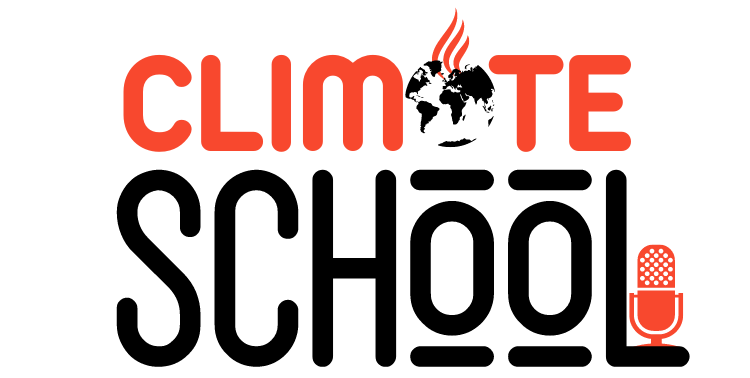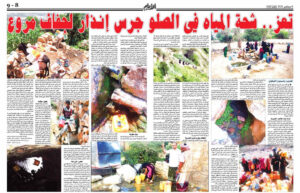Private- Climate School
Written by: Reem Bin Khalifa
The need to understand natural phenomena, environmental problems and climate changes has grown due to the increasing pace of environmental challenges, including the rising temperature of the planet, which is close to breaking the 1.5 degree Celsius barrier, due to emissions and greenhouse gases, in addition to crises such as the water crisis and the global food crisis.
-The importance of environmental podcasts
- Podcasting is an effective tool to spread awareness of environmental issues and contribute to inspiring the public to take action to protect the environment on an individual and collective level.
- Podcasts are also considered low-tech audio production and can be produced through what is called “technological austerity,” thus saving energy from the preparation stage to production and marketing.
- Environmental podcasts can provide practical examples of successful initiatives, such as green project experiences, which allow listeners to follow suit and build a generation committed and interactive with these issues due to its ease of spread and the possibility of downloading and listening to episodes at any time.
-Steps and tips for producing environmental podcasts
There are a set of steps that must be adopted in producing environmental podcasts, which are:
- At the level of form, it is preferable to choose formats such as the interview podcast or the feature (news story) because scientific and specialized topics require dialogue with specialized experts in the field and the provision of accurate information, as it provides the listener with a deep understanding in order to be able to participate in efforts to preserve the environment and adapt to the effects of climate change.
- Choosing a title for the environmental podcast is considered an essential step, and it is not easy either. On the one hand, the title must reflect the main idea presented in the podcast, and on the other hand, it must not be consuming, existential, and immersed in directness to ensure the marketing of the content later.
- The podcast creator should understand the basic terms in the field of environment and climate change, such as emissions, carbon footprint, green transition, adaptation, and other basic keys, as any lack of understanding or confusion between definitions can create fallacies among the audience.
- The podcast creator must also keep up with environmental conferences, events, and protests, and review major environmental agreements and decisions taken during conferences such as COP (the Conference of the Parties), which is an international conference held annually at the end of the year. It serves as a decision-making body, and is responsible for monitoring and reviewing the implementation of the agreement. The United Nations Framework Convention on Climate Change (UNFCCC), and subsequent international agreements, and the states parties that signed the agreement participate in this conference.
- Considering the topic of the environment and climate change are current and changing topics, the topics must be chosen wisely, keeping up with all developments, and arranged according to geographical and emotional proximity so that the listener feels that he is part of the podcast.
- In the same context, it is important to cooperate with local and regional environmental organizations, depending on the target audience, because this contributes to promoting the podcast, networking, and opening opportunities for cooperation with non-profit organizations working in the field of environment and sustainability. The podcast creator can host activists or present their projects and initiatives through podcast episodes.
- Environmental podcasts encourage a sustainable lifestyle by directing the audience towards adopting sustainable methods in their daily lives. Including human stories that include the effects of climate change and environmental disasters on individuals and communities helps attract listeners and makes them feel like they are part of the story.
- The script must be divided into a group of paragraphs, starting with the introduction, questions, and then the conclusion in the interview podcast. This can include interviews with environmental experts, reports on environmental projects, advice for environmentally friendly daily living, and coverage of environmental conferences or protests.
- If the podcast contains more than one topic, the episode can be divided into paragraphs interspersed with music for relief and comfort for the listener’s ears, although it is advisable to present each topic in a separate episode, no matter how closely related it is, because environmental and climate issues require understanding and simplification.
- On the technical level, podcasts are considered among the low-tech media productions, and it is recommended to use sustainable and low-tech technology, and to measure the environmental impact, as they are the most encouraging of adopting environmentally friendly practices. To achieve a balance between the technological performance of the podcast and its environmental impact, the environmental impact of the podcast production process must be monitored and evaluated, and methods must be constantly searched for. Continuous improvement and reduction of the environmental footprint of the process.
- The process of changing environmental behaviors begins with technological and energy austerity in podcast production by adopting recording and production equipment that relies on renewable energy sources such as solar energy, and is flexible, repairable and recyclable, reducing the use of plastic and paper materials that can be disposed of after use, and relying on digital tools and virtual technologies in production. Attention should also be paid to the quality of the equipment to achieve the best possible audio results.
- The necessary equipment must be prepared in advance, as well as the audio content and delivery method, as they are essential elements in promoting the podcast.
- After modifying the content and adding sound effects, the episodes can be uploaded to various podcast platforms such as Apple Podcasts, Spotify, SoundCloud, and others.
- When publishing, podcasters use hashtags on social media to promote your podcast and attract a wider audience.
Examples of environmental podcasts:
Examples of environmental podcasts that explain phenomena and how to adapt to them in the Middle East and North Africa include:
– Green Podcast.
Environment and Style podcast.
-green lemon.
- Zero carbon.
-Dry flood.
At the global level, we find various examples, the most famous of which are:
-Podcast Bioneers: Revolution from the Heart of Nature
It highlights innovative solutions to environmental challenges, and includes interviews with environmental scientists and activists.
-Podcast Green Dreamer
Its definition states that it is a path towards collective environmental healing and the revitalization of biological culture.
.





